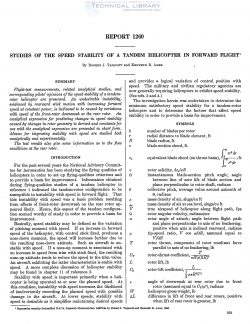naca-report-1260
- Version
- 190 Downloads
- 974.82 KB File Size
- 1 File Count
- November 2, 2016 Create Date
- November 2, 2016 Last Updated
National Advisory Committee for Aeronautics, Report - Studies of the Speed Stability of a Tandem Helicopter in Forward Flight

Flight—test measurements, related analytical studies, and
corresponding pilots’ opinions of the speed stability of a tandem-
rotor helicopter are presented. An undesirable instability,
evidenced by rearward stick motion with increasing forward
speed at constant power, is indicated to be caused by variations
with speed of the front—rotor downwash at the rear rotor. An
analytical expression for predicting changes in speed stability
caused by changes in rotor geometry is derived and constants for
use with the analytical expression are presented in chart form.
fileans for improving stability Wk speed are studied both
analytically and experimentally.
The test results also give some information as to the flow
conditions at the rear rotor.
For the past several years the National Advisory Commit-
tee for Aeronautics has been studying the flying qualities of
helicopters in order to set up flying-qualities criterions and
to provide a basis for improvement. Information obtained
during flying-qualities studies of a tandem helicopter in
reference 1 indicated the tandem-rotor configuration to be
susceptible to instability with speed in forward flight. That
this instability with speed was a basic problem resulting
from effects of front-rotor downwash on the rear rotor ap-
peared likely. Hence, this aspect of the tandem configura-
tion seemed worthy of study in order to provide a basis for
improvement.
Basically, speed stability may be defined as the variation
of pitching moment with speed. If an increase in forward
speed of the helicopter, with control stick fixed, produces a
nose-down moment, the speed will increase further due to
the resulting nose-down attitude. Such an aircraft is un-
stable with speed; If a nose—up moment is associated with
an increase in speed from trim with stick fixed, the resulting
nose-up attitude tends to reduce the speed to the trim value.
An aircraft exhibiting the latter characteristics is stable with
speed. A more complete discussion of helicopter stability
may be found in chapter 11 of reference 2.
| File | Action |
|---|---|
| naca-report-1260 Studies of the Speed Stability of a Tandem Helicopter in Forward Flight.pdf | Download |

Comment On This Post